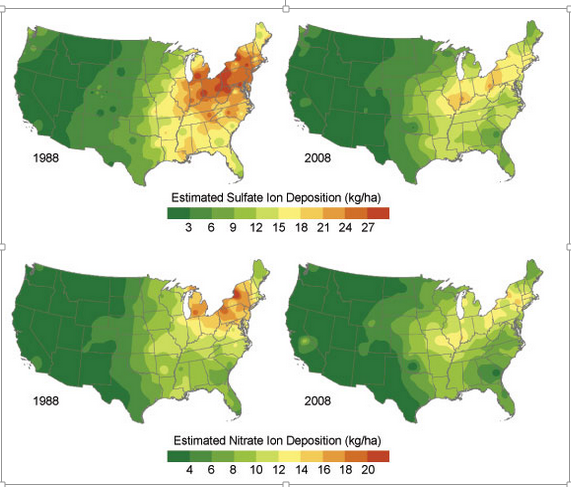Red spruce stand in the Monongahela National Forest. Credit: Justin Mathias
The Clean Air Act, implemented in 1990, has been heralded as an economic and environmental success story that has led to cuts in ground-level ozone by more than 25% since 1980, a reduction in mercury emissions by 45%, and a decrease in the main drivers of acid rain — sulfur dioxide by 71% and nitrogen dioxide by 46%.
The Clean Air Act has also had significant positive effects on both human health and our nation's waterways. New research from Justin Mathias and Richard Thomas at West Virginia University, is showing that the Clean Air Act may signify even better news for our forests than we thought.
Red spruce once dominated the mountains of the central Appalachia, from West Virginia south into North Carolina. These once towering denizens of the forest, now only reside in isolated patches at high altitude. Red spruce numbers have been impacted by logging, fire, and land use.
There has been interest in restoring red spruce throughout the mid Appalachians, but to inform that effort, research has been required to understand the environmental stressors affecting red spruce.
Mathias is using isotopic analysis on red spruce tree rings gathered from trees in the Monongahela National Forest in West Virginia to recreate past stomatal conductance — a measure of the amount of CO2 entering, or water vapor exiting, a leaf's stomata, the small pores on the bottom of a leaf. Previous research has shown that a loss of stomatal function is one of the primary avenues for reduced growth when trees are exposed to acid deposition.
National Atmospheric Deposition Program (NADP) data showing decreases in nitrate and sulfate ions spatially across the US between 1988 and 2008.
Reconstructions of past stomatal conductance are possible through the fractionation of the 13C isotope, a heavier, yet still stable form of carbon. The primary enzyme involved in carbon fixation, Ribulose-1,5-bisphosphate carboxylase/oxygenase, better known as RuBisCo, has a stronger affinity for the lighter, more common molecule of carbon (12C) over the heavier molecule of carbon (13C). That relationship can lead to valuable ecological and scientific insights. "The differences in mass between the lighter and heavier isotope found in plant biomass," said Mathias, "provide information about the diffusive and biochemical processes of photosynthesis."
There are, however, competing ecological processes occurring here through time. With increasing atmospheric carbon dioxide, plants have increased their intrinsic water use efficiency (iWUE). iWUE is the ratio of carbon gain to stomatal conductance. Closing of the stomata results in lower stomatal conductance, yet increases the efficiency of growth due to the increase in WUE as the plant is able to fix more carbon with less water or with fewer stomata.
However, Mathias's work is showing that increases in WUE are not the whole story, "It's not just carbon dioxide, it's also pollution that are closing the stomata and reducing conductance," said Mathias.
The decreased growth and vitality of red spruce stands before 1990 shows up as steeply decreasing stomatal conductance through time in Mathias's reconstructions.
Corresponding to the implementation of the Clean Air Act though, is a noticeable and sharp increase in stomatal conductance in the tree ring record.
"The increases in stomatal conductance after the Clean Air Act are strongly correlated with large declines in pollutant emissions in the U.S. and, more locally, with reductions in acid deposition," said Mathias.
"One of the most important aspect of Justin's work," said Richard Thomas his advisor and research collaborator, "is that he is showing evidence of how effective the Clean Air Act has been for these forests in a time when this landmark environmental legislation is under fire and that's no small thing."
This study builds on past work from Richard Thomas published in PNAS in 2013.
Justin Mathias' nicely paced presentation, entitled "Using tree rings of red spruce in the Central Appalachian Mountains to explore growth trends before and after the Clean Air Act," was a contributed talk in the ESA Physiological Ecology I session on Monday, August 10th. It was well received by the crowd. I was particularly struck at his poise and demeanor, especially given that Justin is still relatively early in his doctoral work.
Journal information: Proceedings of the National Academy of Sciences
Provided by Public Library of Science
This story is republished courtesy of PLOS Blogs: blogs.plos.org.






















